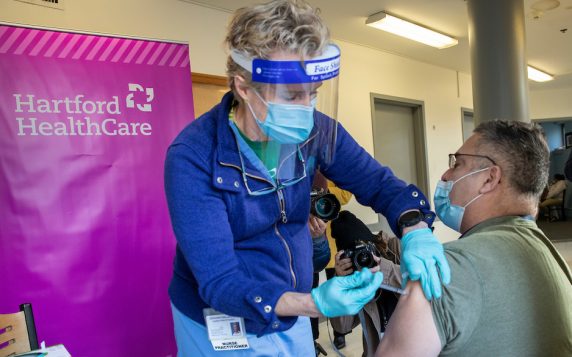For the second straight year, we’re sharing our holidays with COVID-19. But Connecticut, and much of the nation, promise to be much safer places to celebrate.
So what’s your risk of COVID-19 exposure compared to last year if you celebrate Thanksgiving at a gathering of 10, or even 15 people? Georgia Institute of Technology scientists developed an interactive map that, using multiple data sources, assesses your risk anywhere in the country.
This tool allows you to select how many people will be in the same room and, based on the level of cases in your county, calculates the probability that at least one person will have COVID-19 and possibly infect others. (The calculations assume there are between three and five times more cases in a given area than are being reported.) You can also check on much larger gatherings, such as holiday shopping or crowded restaurants.
In Connecticut, here are the chances in each county that at least one COVID-positive person will attend a gathering with either 10 people or, in parenthesis, 15 people:
- Hartford: 6 percent (8 percent).
- Tolland: 5 percent (8 percent).
- Middlesex: 5 percent (8 percent).
- New Haven: 6 percent (9 percent).
- Windham: 13 percent (19 percent).
- New London: 10 percent (15 percent).
- Litchfield: 9 percent (13 percent).
- Fairfield: 4 percent (7 percent).
Here are the Thanksgiving numbers from last year, again for parties of 10 and, in parenthesis, 15 people:
- Hartford: 20 percent (28 percent).
- Tolland: 16 percent (23 percent).
- Middlesex: 18 percent (26 percent).
- New Haven: 23 percent (32 percent).
- Windham: 16 percent (22 percent).
- New London: 14 percent (21 percent).
- Litchfield: 19 percent (27 percent).
Windham and New London counties remain relatively high-risk areas this holiday season where people should pay close attending to safety recommendations.
“The suggestion is if there are unvaccinated (at the gathering) you should probably wear masks unless you are eating,” says Dr. Ulysses Wu, Hartford HealthCare’s System Director of Infection Disease and Chief Epidemiologist. “And even if you are eating, maybe you should be socially distant to a certain extent.”
Today’s update from the state Department of Public Health:
It's OK to ask if your guests have been vaccinated and, if not, if they'd be willing to get tested.
"Don't be afraid to ask the questions before individuals comment on whether or not they've been vaccinated," says Keith Grant, APRN, Hartford HealthCare's Senior Director of Infection Prevention. "It would be helpful if they've previously tested negative and, most important, if they have any form of symptoms. I wouldn't accept, 'It's just allergies.' I would be very cautious with statements such as that."
The Centers for Disease Control and Prevention offers these tips for a safer holiday season:
- Protect those not yet eligible for vaccination such as young children by getting yourself and other eligible people around them vaccinated.
- Wear well-fitting masks over your nose and mouth if you are in public indoor settings if you are not fully vaccinated. Even those who are fully vaccinated should wear a mask in public indoor settings in communities with substantial to high transmission. Outdoors is safer than indoors.
- Avoid crowded, poorly ventilated spaces.
- If you are sick or have symptoms, don’t host or attend a gathering.
- Get tested if you have symptoms of COVID-19 or have a close contact with someone who has COVID-19.
"The original projection model said numbers were going to decline after September," says Dr. Wu, "which we really never felt that was going to be the case. We always knew numbers were going to rise for several reasons. No. 1 is the holidays. No. 2 is the cold weather with people gathered inside. And No. 3 is the lack of mask mandates at this point. So we expect numbers to rise with the holidays. That's why everybody should get vaccinated."




